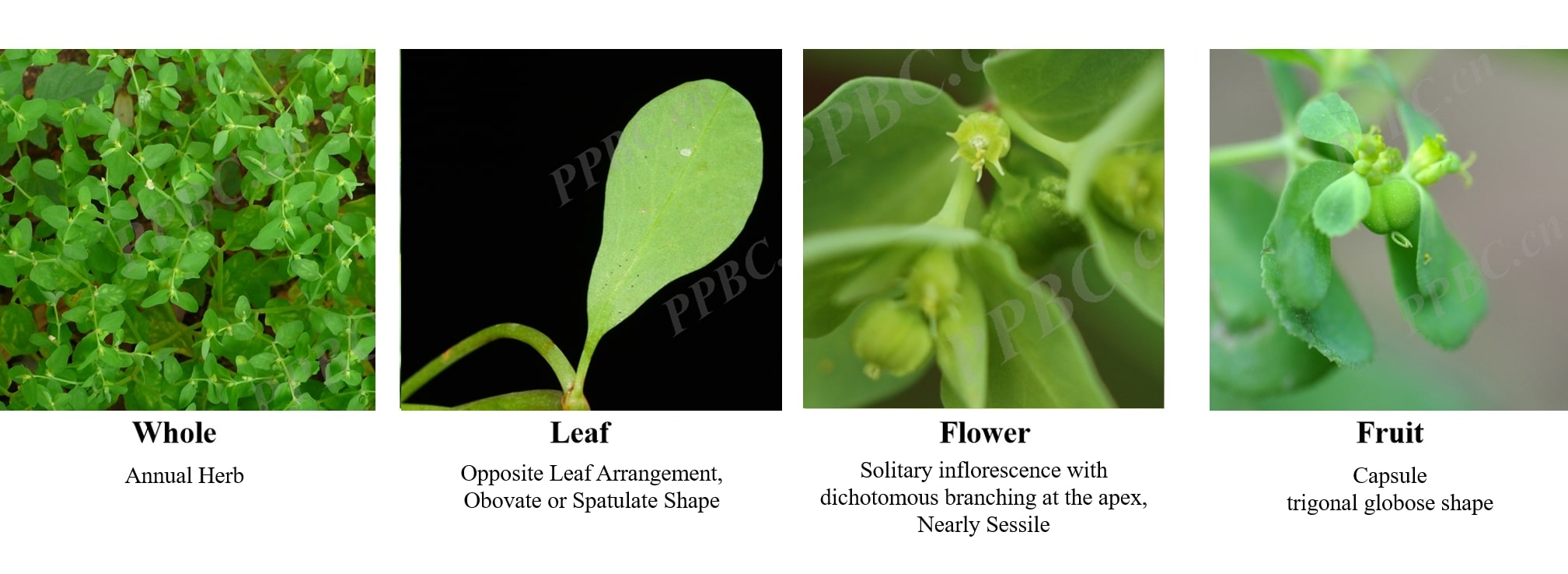Overview
| Species: | Euphorbia peplus |
| Genus: | Euphorbia |
| Family: | Euphorbiaceae |
| Taxonomy ID: | 38846 |
| Common Name: | Tithymalus peplus; Esula peplus. |
Morphology

Introduction
Euphorbia peplus (petty spurge) is an annual herbaceous plant in the Euphorbiaceae family. It possesses medicinal properties such as anti-inflammatory[1], antibacterial[2], anticancer[3], and blood sugar-lowering effects[4].
Notably, ingenol mebutate found in its latex has been used as a drug due to its excellent efficacy against skin cancer[5].
Due to its small size, ease of laboratory handling, and rapid reproduction cycle, Excoecaria agallocha holds great potential as a model for plant latex production. Johnson assembled its genome[6], providing significant support for research on latex production in the Euphorbiaceae family and the biosynthesis of ingenol mebutate..
Due to its small size, ease of laboratory handling, and rapid reproduction cycle, Excoecaria agallocha holds great potential as a model for plant latex production. Johnson assembled its genome[6], providing significant support for research on latex production in the Euphorbiaceae family and the biosynthesis of ingenol mebutate..
Genome information
| Specie type | Genome size | Assembly level | Scaffold N50 | CG content | Browse | Data Source(PMID) |
|---|---|---|---|---|---|---|
| Euphorbia peplus | 267.2Mb | Chromosome | 34.6 Mb | 35% | 36757383 |
Reference
[1]Li, Y., Yu, Z. P., Li, Y. P., Yu, J. H., & Yue, J. M. (2024). Diterpenoids from Euphorbia peplus possessing cytotoxic and anti-inflammatory activities. Bioorganic chemistry, 145, 107194. https://doi.org/10.1016/j.bioorg.2024.10719499
[2]Hua, J., Liu, Y., Xiao, C. J., Jing, S. X., Luo, S. H., & Li, S. H. (2017). Chemical profile and defensive function of the latex of Euphorbia peplus. Phytochemistry, 136, 56–64. https://doi.org/10.1016/j.phytochem.2016.12.021
[3]Ramsay, J. R., Suhrbier, A., Aylward, J. H., Ogbourne, S., Cozzi, S. J., Poulsen, M. G., Baumann, K. C., Welburn, P., Redlich, G. L., & Parsons, P. G. (2011). The sap from Euphorbia peplus is effective against human nonmelanoma skin cancers. The British journal of dermatology, 164(3), 633–636. https://doi.org/10.1111/j.1365-2133.2010.10184.x
[4]Alruhaimi, R. S., Mostafa-Hedeab, G., Abduh, M. S., Bin-Ammar, A., Hassanein, E. H. M., Kamel, E. M., & Mahmoud, A. M. (2023). A flavonoid-rich fraction of Euphorbia peplus attenuates hyperglycemia, insulin resistance, and oxidative stress in a type 2 diabetes rat model. Frontiers in pharmacology, 14, 1204641. https://doi.org/10.3389/fphar.2023.1204641
[5]Gras J. (2013). Ingenol mebutate: a new option for actinic keratosis treatment. Drugs of today (Barcelona, Spain : 1998), 49(1), 15–22. https://doi.org/10.1358/dot.2013.49.1.1910723
[6]Johnson, A. R., Yue, Y., Carey, S. B., Park, S. J., Kruse, L. H., Bao, A., Pasha, A., Harkess, A., Provart, N. J., Moghe, G. D., & Frank, M. H. (2023). Chromosome-level Genome Assembly of Euphorbia peplus, a Model System for Plant Latex, Reveals that Relative Lack of Ty3 Transposons Contributed to Its Small Genome Size. Genome biology and evolution, 15(3), evad018. https://doi.org/10.1093/gbe/evad018
[2]Hua, J., Liu, Y., Xiao, C. J., Jing, S. X., Luo, S. H., & Li, S. H. (2017). Chemical profile and defensive function of the latex of Euphorbia peplus. Phytochemistry, 136, 56–64. https://doi.org/10.1016/j.phytochem.2016.12.021
[3]Ramsay, J. R., Suhrbier, A., Aylward, J. H., Ogbourne, S., Cozzi, S. J., Poulsen, M. G., Baumann, K. C., Welburn, P., Redlich, G. L., & Parsons, P. G. (2011). The sap from Euphorbia peplus is effective against human nonmelanoma skin cancers. The British journal of dermatology, 164(3), 633–636. https://doi.org/10.1111/j.1365-2133.2010.10184.x
[4]Alruhaimi, R. S., Mostafa-Hedeab, G., Abduh, M. S., Bin-Ammar, A., Hassanein, E. H. M., Kamel, E. M., & Mahmoud, A. M. (2023). A flavonoid-rich fraction of Euphorbia peplus attenuates hyperglycemia, insulin resistance, and oxidative stress in a type 2 diabetes rat model. Frontiers in pharmacology, 14, 1204641. https://doi.org/10.3389/fphar.2023.1204641
[5]Gras J. (2013). Ingenol mebutate: a new option for actinic keratosis treatment. Drugs of today (Barcelona, Spain : 1998), 49(1), 15–22. https://doi.org/10.1358/dot.2013.49.1.1910723
[6]Johnson, A. R., Yue, Y., Carey, S. B., Park, S. J., Kruse, L. H., Bao, A., Pasha, A., Harkess, A., Provart, N. J., Moghe, G. D., & Frank, M. H. (2023). Chromosome-level Genome Assembly of Euphorbia peplus, a Model System for Plant Latex, Reveals that Relative Lack of Ty3 Transposons Contributed to Its Small Genome Size. Genome biology and evolution, 15(3), evad018. https://doi.org/10.1093/gbe/evad018